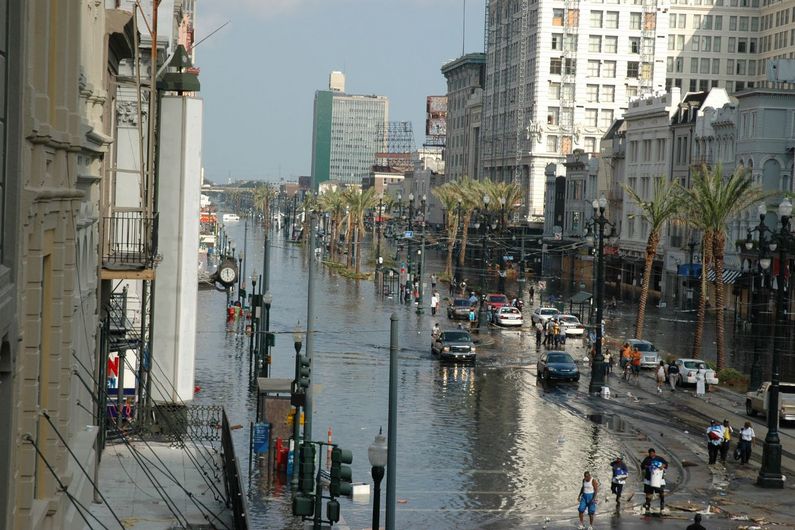Climate refugees: millions on the move
- UdeMNouvelles
10/24/2023
- Béatrice St-Cyr-Leroux
More and more migrants are fleeing climate change. What are the legal and political implications of this complex phenomenon?
“Climate change is pushing millions of people into famine. It is destroying hopes, opportunities, homes and lives... The dystopian future is already here,” said Volker Türk, United Nations High Commissioner for Human Rights, just a few weeks ago.
It was a stark warning about the climate crisis and its all-too-real impact on migration flows.
Faced with the repercussions of climate change – whether direct (drought, floods, storms and wildfires) or indirect (poverty, food insecurity, shortages of water and other natural resources) – many people have no choice but to leave their homes and move, sometimes to other countries.
According to the UN, over the last decade weather events have displaced an average of 21.5 million people per year. That’s twice as many as those who've fled violence and conflict.
Is there a legal framework for this kind of migration? What resources are available for climate refugees? How can governments help them? What should we call these waves of migration? How does the public view climate refugees?
These are the questions examined by Sarah Munoz, a doctoral student in political science at Université de Montréal under the direction of professors Erick Lachapelle and Pascale Dufour.
No clear definition
Refugee status is protected under international law. It applies to people who suffer persecution due to their political opinion, membership in a social group, religion or nationality.
But people who abandon their homes because of climate change aren’t officially recognized as refugees, even though they leave to protect their safety, health, well-being and very existence.
And the term “climate refugee” still has no legal definition.
Munoz says that even if “refugee” doesn’t accurately describe these groups, a fair description of their situation would be “displacement.” A more accurate term for the phenomenon would be “climate migration,” since it better reflects the complexity of the issue, she said.
“There are several types of migration: non-migration (remaining in place despite the risk), circular migration (leaving and then coming back), internal migration (leaving for another region in the same country, the most popular kind of migration) and international migration (crossing a border),” she explained.
Influencing public opinion
The right terms matter because they influence public opinion. In a recent study carried out in collaboration with Lachapelle and his colleague Richard Nadeau, Munoz noted that Canadians are less inclined to welcome “climate migrants” than “people fleeing climate change.”
“Other studies also show that people apparently don’t have as much sympathy for climate migrants since they aren’t being oppressed by a political regime,” she said. “In Germany, however, people believe that Europe is partly responsible for climate change, and therefore the EU has a responsibility to assist ‘victimized’ countries.”
Munoz added that peoples’ views of climate refugees or migrants vary depending on their country and the political opinions they already have regarding migration and climate change. For example, conservatives would be more likely to reject this new category of potential newcomers.
This is important because public opinion ultimately influences political will, which is key to improving the conditions of vulnerable communities and their ability to adapt, the researchers say.
Politics is key
For Munoz, politics is a key factor in climate migration.
Vulnerable communities often feel they have to remain in place, despite the risks, when governments indulge in climate denialism and don’t invest much (or at all) in the social and economic policies that would help them adapt to climate change, she said.
In contrast, migration seems to be easier when governments have policies that improve climate resilience.
“This could include offering financial aid to relocate people whose houses are losing value, adapting urban infrastructure to accommodate displaced communities, and considering identity-related issues for indigenous populations whose culture and way of life are very closely tied to the land they live on,” Munoz said.
Louisiana: a case study
Take Louisiana, for example, a place Munoz is studying. The southern U.S. state is one of the most vulnerable to the impact of climate change because it regularly faces extreme weather events, heat, drought and flooding.
Most of the state’s budget focuses on infrastructure policies, with billions of dollars spent on levees, walls and pumps. “The government doesn’t want people to leave since that would affect tax revenues and the number of seats Louisiana has in the House of Representatives,” she said.
Louisiana doesn’t offer much of a social safety net, and its political discourse is focused on the importance of maintaining the status quo, she noted.
“Hurricanes are being normalized as part of the Louisiana experience, or as an act of God. This normalizes risk and vulnerability, while absolving the government of responsibility. The thinking is that humans bear no responsibility for these issues and therefore nothing can be done.
"And that means no one thinks twice about questionable practices like building in flood zones that are vulnerable over the long term.”














